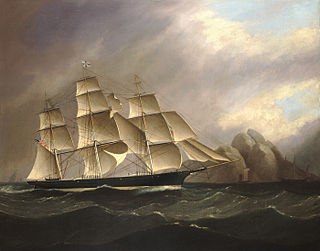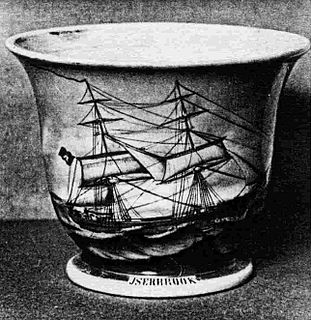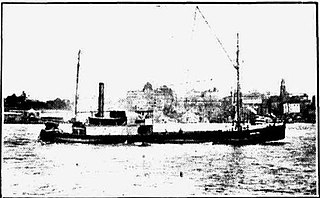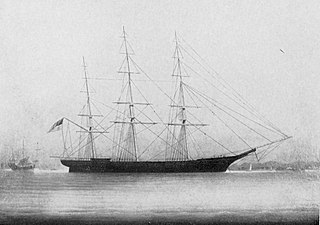
USS Santiago de Cuba (1861) was a side-wheel steamship acquired by the Union Navy during the first year of the American Civil War. She was outfitted as a gunboat with powerful 20-pounder rifled guns and 32-pounder cannon and was assigned to the Union blockade of the Confederate States of America. She was notably successful in this role, capturing several blockade runners. Her last major action of the war was the assault on Fort Fisher, during which seven of her crew won the Medal of Honor.

The Illawarra Steam Navigation Company was a shipping company that serviced the south coast of New South Wales, Australia from 1858 to the early 1950s. It was formed through the amalgamation of the General Steam Navigation Company, the Kiama Steam Navigation Company and the Shoalhaven Steam Navigation Company, each of whom serviced parts of the south coast with their respective vessels. After merging, the new company held a near monopoly in regard to shipping on the south coast, and their fleet visited every significant port between Sydney and the border of Victoria. The company transported both passengers and a range of produce, including livestock, and hence it became known as the 'Pig and Whistle Line': it was said that ships would wait an hour for a pig but not a minute for a passenger.

Elizabeth Reef, located at 29°57′25″S159°4′32″E is a coral reef in the Coral Sea. The reef is separated by a deep oceanic pass, some 47 km wide, from nearby Middleton Reef, both of which are part of the underwater plateau known as the Lord Howe Rise. It is around 175 km from Lord Howe Island and 555 km from the New South Wales coast of Australia. The Environment, Sport and Territories Legislation Amendment Act 1997 included Elizabeth Reef in Australia's Coral Sea Islands Territory.

The Acielle was a 70-foot (21 m) wooden ketch that was wrecked 15 miles (24 km) south of Smoky Cape, New South Wales on 11 September 1929.
The Advance was a composite schooner built in 1874 at Auckland, New Zealand, that was wrecked when she drifted onto rocks at Henrys Head, Botany Bay, New South Wales, Australia, on 12 June 1902, whilst carrying ballast between Wollongong and Newcastle, New South Wales.
Aeolus was a wooden ketch built in 1850 at Pyrmont, New South Wales, Australia. She was carrying timber to Sydney, New South Wales, when she was lost at Hole in the Wall, Jervis Bay, New South Wales, on 24 October 1867. The wreck has not been located, but its approximate position is 35.134648°S 150.745874°E.

The Narara was a wooden carvel screw steamer built in 1900 at Jervis Bay, that was wrecked when it sprang a leak while carrying general cargo between Sydney and the Hawkesbury River and was lost at 2 ml SE off Little Reef Newport near, Barranjoey, New South Wales on 29 May 1909. The vessel commenced her runs from Sydney Harbour to the Hawkesbury River in January 1900 and continued on this run till the time of her final 1909 sinking. During 1903 the vessel was burned to the water line and sank at its mooring only to be refloated and rebuilt and started back on the same run.

The Koonya was a wood carvel screw steamer built in 1887 at Hobart, that was wrecked when it stuck the shore at Doboy reef whilst carrying passengers & cargo between Moruya and Sydney and was lost off Cronulla Beach, Port Hacking, New South Wales on 25 January 1898.

Ocean Telegraph was a clipper ship that was built in Massachusetts in 1854 and was last known of in Gibraltar in 1923. She was in US ownership until 1863, when UK interests bought her and renamed her Light Brigade.

James Henry Young was an Australian colonial businessman and politician and Speaker of the New South Wales Legislative Assembly.

Henry Douglas Morton, often referred to as "Harry" or Harry D. Morton, was an Australian politician.

The Nimbin was a steel screw steamer built in 1927 at Copenhagen, that was the first motor vessel placed into the New South Wales coastal trade. It was owned and operated by the North Coast Steam Navigation Company and was the first Australian registered merchant ship to be lost during World War II when it struck a mine laid by the German auxiliary cruiser Pinguin. The Nimbin was on its way from Coffs Harbour to its home port, Sydney, with a cargo of bundled three-ply timber and a cargo of pigs. One third of the ship was blown away and it sank in three minutes. Seven men were killed. The remaining thirteen clung to bundles of plywood. Some hours later an air force plane from RAAF Base Rathmines saw the survivors and directed the coastal ship SS Bonalbo to the scene to retrieve them.

Colonist was a general cargo and passenger schooner built in 1861 at Dumbarton Scotland by Denny & Rankine. It spent nearly 30 years plying the Western Pacific-based out of Sydney. It wrecked and later re-floated on the remote Elizabeth Reef 550 km from New South Wales, as well as being involved in the gold rushes. Its master was murdered before it was finally involved in a collision in Sydney Harbour, in which it was sunk.

Iserbrook was a general cargo and passenger brig built in 1853 at Hamburg (Germany) for Joh. Ces. Godeffroy & Sohn. It spent over twenty years as an immigrant and general cargo vessel, transporting passengers from Hamburg to South Africa, Australia and Chile, as well as servicing its owner's business in the Pacific. Later on, the vessel came into Australian possession and continued sailing for the Pacific trade. In 1878 it caught fire and was sunk the same year. At last, it was re-floated and used as a transport barge and hulk in Sydney until it sank again and finally was blown up.
SS Kate was a wooden carvel screw steamer built in 1883 at Balmain that was twice struck and sunk by Port Jackson & Manly Steamship Company ferries.

Arthur Alexander Walton Onslow was born at Trichinopoly in India to surveyor Arthur Pooley Onslow and Rosa Roberta Macleay. In 1838 was sent to New South Wales, where he lived with his grandfather Alexander Macleay at Elizabeth Bay House in Sydney. He returned to England to live with his family in 1841 and was educated in Surrey and Nottingham. He entered the navy in May 1847 as a midshipman on HMS Howe and by 1847 he was a navy midshipman.

The Queen Bee was a wooden carvel Twin-screw steamer built in 1907 at Davistown, New South Wales, that was wrecked when she sprang a leak whilst carrying coal other general cargo between Sydney and Newcastle, New South Wales. She was lost off Barrenjoey Head, Broken Bay, New South Wales on 2 September 1922.

The Stone Fleet was the colloquial name for the small coastal ships that carried crushed-stone construction aggregate to Sydney from the Illawarra ports of Kiama and Shellharbour and the nearby ocean jetties at Bombo and Bass Point. The coastal shipping trade carried on by these ships was known colloquially as the 'Stone Trade' or 'Blue Diamond Trade'. The trade ended finally in 2011.

Gravina was an 818-register ton clipper ship built in Hoboken, New Jersey, in 1853. A rare example of a clipper built in the United States for foreign owners, Gravina was originally homeported in Spain, though commanded by an American.

Named after her designer Donald McKay was built for James Baines & Co. She was the last extreme clipper ship built by Donald McKay. Donald McKay sailed on the Black Ball Line of Liverpool from 1855 to 1868, bringing passengers and mail from England to Australia.
















